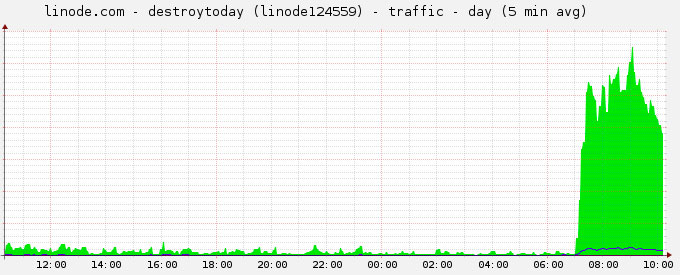Dear Lifehacker, As a side project/experiment, I’ve started my own blog. The problem is, now that I have one, how can get people to actually visit it? My traffic is dismal so far, but I’m hoping to some day make money off the blog or at least become a more prominent blogger. Signed, Beginner Blogger
Dear BB,
Congrats on your new blog baby. Starting and maintaining a blog can definitely be rewarding, and not just in the financial sense. But it’s not just enough to choose a platform and set up a blog or spend hours carefully crafting posts. To be successful, you need to build and continue to grow an audience. So here are seven tried-and-true methods for increasing your blog’s traffic, whether this is just a hobby or something you want to do for income.
1. Find Your Niche

The broader and more general your blog’s topic (e.g. technology), the harder it will be to gain an audience, because of all the bigger, already established websites competing for the same readers. At the same time, you want to make sure your blog isn’t so specific that there aren’t enough people looking for that particular information or you run out of things to write about. Focus your blog on a unique angle and make sure your subject is one that you’re both passionate about and feel you could write lots of posts on.
Not sure what your blog’s main subject should be? Think about your hobbies, topics you like to talk about and debate with others, and subjects you love reading and researching. Boost Blog Traffic offers straightforward guidelines for how to tell if you’ve chosen the right blog topic or not. Among the recommendations, measure your interest and the topic’s viability by checking: how many books you own on the topic, if there’s already an audience for your topic, and whether you can come up with at least 52 different post ideas (one for every week of the year).
Once you’ve decided on your blog’s theme, stick to it. (That means no middle-of-the-night, out-of-the-blue rants!) Consistency is the key to getting the audience you’ve already attracted to keep coming back for your great content.
2. Keep Writing Great Content
Speaking of great content, what makes posts popular and more likely to be shared? Generally speaking, great posts: answer a question, solve a problem, make readers laugh, or make them cry (in a good way).
Also, no matter how long or short a post is, format it so readers can quickly scan the content by using:
- subheads
- bulleted or numbered lists
- blockquotes or captions
- line breaks
- bold fonts
- images
- and other formatting to break up large blocks of text
If you can build a habit of writing every day, awesome. Quite simply, the more useful content you have out there, the better your chances of readers finding your blog. Even if you can’t write every day, aim to post often and regularly so readers will keep coming back for more and you can build a loyal audience base.
On the other hand, as blogger Cherly Harrison advises, don’t blog just for the sake of it or just because you’ve set a Monday, Wednesday, Friday schedule. Publish when you have quality content:
I have never heard anyone say “I unsubscribed from Blog X because he didn’t post this week.” I have heard dozens of people say “I unsubscribed from Blog X because it was obvious he was stretching for content.”
There’s no perfect blogging schedule for everyone, but focus on what you enjoy writing about and carve out time to work on it. This will help you get to the point where you’re posting regularly without pushing it.
Know also that it can take quite a bit of time to grow your blog, and you’ll need to keep at it, especially if you plan to make money by blogging. (See this post from The Financial Blogger for a reality check.) So don’t get disheartened if you don’t see quick results. Persist.
3. Write Catchy, Head-Turning Headlines

Headline writing is an art unto itself, and it’s one of the biggest drivers of a post’s popularity and success. Attention-grabbing headlines can make or break your post. One huge example is how Forbes repackaged a New York Times article titled “How Companies Learn Your Secrets” to “How Target Figured Out a Teen Girl Was Pregnant Before Her Father Did” and got all the traffic: 680,000 page views versus the original article’s 12,902.
Taking a cue from some of the best copywriters of all time, Copyblogger suggests you spend half the time it takes to write a blog post on the headline, because it’s that important. The writing blog offers this approach from the American Writers & Artists association about the Four U’s of writing headlines:
Headlines, subheads and bullets should:
- Be USEFUL to the reader,
- Provide him with a sense of URGENCY,
- Convey the idea that the main benefit is somehow UNIQUE; and
- Do all of the above in an ULTRA-SPECIFIC way.
Just make sure if your headline promises a lot, the post itself fulfils that promise.
Here at Lifehacker, I’ve benefited a lot from bouncing headline ideas off my fellow editors. You can do the same for your important blog posts by asking friends for their opinions or just taking a look at similar, highly popular blogs to see what kinds of titles tend to be more intriguing to readers.
4. Join in on the Blogging Community
No blog is an island. Now that you have a blog, you’re part of the blogging community, and reciprocation plays a large part of that. A few things you can do to connect with other bloggers (and probably get reciprocal traffic):
- Link generously. It’s not only good form to cite your sources, but links in your posts make your posts more search engine friendly.
- Leave comments and trackbacks on fellow blogs. Leaving a trackback posts a comment on the other blog noting that you’ve linked to that post. It has a dual effect of virtually tapping the fellow blogger on the shoulder and also putting your blog link in front of more readers.
- Update your blogroll. The list of “blogs you like” in the blogroll help other bloggers notice you. (And if you get listed on other blogs, more readers noticing yours.)
- Try to turn random readers into loyal ones as well. Engage with commenters on your blog, set up an email newsletter and encourage feedback.
- Invite others to guest post or even ask readers to contribute to your blog. You can double your promotion power this way.
- See if you can guest post or contribute to other, larger blogs. This is another great way to get noticed.
Even if you just give a larger site permission to republish your content, it can be a huge boon for you. For example, we republished a post from Jonnie Hallman of Destroy Today, which generated a whole lot of traffic to the source blog:

Even getting a mention or link back to your post from a popular site can drive a lot of traffic and get your blog noticed, your content read, and more readers.
5. Learn From Your Existing Audience
Perhaps the most important thing to do is know your audience and make sure your content continues to interest them. Tips & Tricks HQ advises:
Audiences are far more prone to read something that continues to appeal to them and gets updated regularly, and thus a happy medium between consistency and diversity without compromising quality or credibility is what’s going to give you results.
If you install Google Analytics on your blog (or use another analytics program), you can see which topics your audience particularly likes, where your readers are coming from and lots more. Once you know that, you can create more content to attract similar people and also keep your audience coming back.
Also, social media can be a really powerful tool for getting more readers. In addition to adding the share buttons on your site, share your links on Facebook, Google+, and Twitter — in as non-sleazy, non-spammy way possible.
6. Make Your Blog Google-Friendly
You may have heard the term SEO, or Search Engine Optimisation, before. It basically means writing your blog in a way that makes it more likely to show up in search results, and while it seems like an annoying buzzword, it can be a big help. But you don’t need to go crazy. Frankly, the rules are changing all the time, and it’s probably not worth your time chasing them or changing your content every time Google does an algorithm change that affects search engine rankings.
That said, we do know a few things search engines like, and following those best practices could help your blog get listed higher in search results. Google’s Search Engine Optimization Starter Guide (PDF) recommends you:
- Use unique, accurate and brief page titles
- Use the “description” meta tag
- Make sure your site is easy to navigate
- Use words for your URLs and avoid very long URLs
- Write good anchor (link) text. For example: “Read my SEO report” instead of “Click here”.
- Use headings to mark important sections
- Add an “alt” description to images
Search Engine Watch also has a list of six basic steps to step up your blog’s SEO mojo, including adding related posts to the end of all your blog posts, adding social sharing buttons, and making content easier to find by classifying posts into categories.
For further reading, see Google’s quality guidelines and other recommendations.
7. Write Like Yourself
There are millions of blogs on the web today, so it isn’t easy to stand out. However, if you notice, the top or most popular bloggers have large readerships because of their unique voices and perspectives and the interesting things they share. While you’re crafting your posts, don’t be afraid to let your personality show through so you can really connect to your readers. After all, in the end it’s all about the reader.
There’s much more to learn about making your blog more successful, but hopefully the basics above will get you started. For further reading, consider these sources of excellent blogging and content marketing information:
- ProBlogger: Lots of advice for making a living as a blogger
- About.com Blogging: Comprehensive information for starting, growing and monetising a blog
- CopyBlogger: Advice for creating killer online content
- DailyBlog Tips: Quick, practical tips for becoming a better blogger
Good luck!
Cheers
Lifehacker
Got your own question you want to put to Lifehacker? Send it using our [contact text=”contact form”].
Photos by Olivier Le Moal (Shutterstock), mikecogh.

Comments